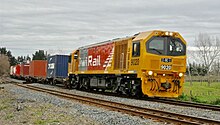| Rail transport in New Zealand | |
|---|---|
 | |
| Operation | |
| National railway | KiwiRail |
| Infrastructure company | New Zealand Railways Corporation (land) KiwiRail (track) Dunedin Railways Various heritage operators |
| Major operators | Auckland One Rail Great Journeys New Zealand Transdev Wellington Dunedin Railways |
| Statistics | |
| Ridership | 35 million a year[1] |
| Freight | 19m tonnes (2018–19)[2] 4.49m net tonne kilometres (2012–13)[3] 16% of total freight movements annually.[4] |
| System length | |
| Total | 4,375.5 km (2,718.8 mi) |
| Double track | 1,332 km (828 mi)[5] |
| Electrified | 1,000 km (620 mi) |
| Freight only | 2,025 km (1,258 mi) |
| Track gauge | |
| Main | 1,067 mm (3 ft 6 in) |
| 1,067 mm (3 ft 6 in) | 4,128 km (2,565 mi) |
| Electrification | |
| Main | 25 kV AC overhead lines |
| 25 kV AC | 488 km (303 mi) |
| 1500 V DC | 101 km (63 mi) |
| Features | |
| No. tunnels | 150 |
| Tunnel length | 80 km (50 mi) |
| Longest tunnel | Freight Kaimai Tunnel 9,025 m (29,610 ft) Passenger Rimutaka Tunnel 8,930.25 m (29,298.7 ft) |
| No. bridges | 1,787 |
| Longest bridge | Freight Rakaia river bridge 1,743 m (5,719 ft) Passenger Waiau river bridge 930.25 m (3,052.0 ft) |
| Highest elevation | 1,600 m (5,200 ft) |
| at | Pokaka, North Island Main Trunk |
| Part of a series on |
| Rail transport |
|---|
 |
|
|
| Infrastructure |
|
|
| Service and rolling stock |
|
| Special systems |
|
|
| Miscellanea |
|
|
| Part of a series on |
| Rail transport in New Zealand |
|---|
 |
Rail transport in New Zealand is an integral part of New Zealand's transport network, with a nationwide network of 4,375.5 km (2,718.8 mi) of track linking most major cities in the North and South Islands, connected by inter-island rail and road ferries. Rail transport in New Zealand has a particular focus on bulk freight exports and imports,[5] with 19 million net tonnes moved by rail annually,[2] accounting for more than half of rail revenue.[6]
Rail transport played an important role in the opening up and development of the hinterland outside of New Zealand's predominantly dispersed and coastal settlements.[7] Starting with the Ferrymead Railway in 1863, most public railway lines were short, built by provincial governments and connected major centres to their nearest seaport (such as Christchurch and its port at Lyttelton Harbour). From the 1870s, the focus shifted to building a nationwide network linking major centres, especially during the Vogel Era of railway construction following the abolition of the provinces. Narrow gauge of 3ft 6in (1,067mm) was adopted nationally. Bush tramways or light industrial railways sprang up connecting to the national network as it expanded. Railways became centrally controlled as a government department under the names New Zealand Government Railways or New Zealand Railways Department (NZR), and land transport was heavily regulated from 1931 onwards. NZR eventually expanded into other transport modes, especially with the Railways Road Services, inter-island ferries and Rail Air service. NZR also had an extensive network of workshops. By 1981, NZR employed 22,000 staff.[8]
In the early 1980s, NZR was corporatised as the New Zealand Railways Corporation and drastically restructured,[8] especially following the deregulation of land transport in 1983. The Corporation became a state-owned enterprise (SOE) in 1987, required to run at a profit. In 1991, the rail, inter-island ferry and infrastructure businesses of the Railways Corporation were split off into a new SOE, New Zealand Rail Limited, which was in turn privatised in 1993, and renamed Tranz Rail in 1995. The parcels and bus service business units were also privatised, and the Railways Corporation continued to dispose of surplus land. The central government renationalised first the Auckland metro railway network in 2001, then the rest of the network in 2004, and finally the rail and ferry operations in 2008, creating another SOE, KiwiRail.[8]
Today, services are primarily provided by KiwiRail and focused on bulk freight, with a small number of tourist orientated passenger services, such as the TranzAlpine, Coastal Pacific and Northern Explorer. Dunedin Railways also operate tourist trains out of Dunedin, and a number of heritage operators run charter specials from time to time. Urban passenger rail services exist only in Auckland and Wellington. Rail in New Zealand has received significant and ongoing government investment since re-nationalisation in 2008, with the two urban rail systems being upgraded. In 2021, the government launched the New Zealand Rail Plan,[9] with funding for rail projects to come from National Land Transport Fund (NLTF), with KiwiRail remaining an SOE but paying Track Access Charges (TACs) to use the network.
- ^ "KiwiRail Annual Integrated Report 2019" (PDF). KiwiRail. 2019. Retrieved 2 December 2019.
- ^ a b "KiwiRail Integrated Report 2019". Archived from the original on 10 June 2021. Retrieved 10 October 2019.
- ^ "KiwiRail Annual Report 2014" (PDF). KiwiRail. 2014. Retrieved 7 March 2019.
- ^ Cite error: The named reference
freight study 2014was invoked but never defined (see the help page). - ^ a b "Future Freight Scenarios Study". Ministry of Transport (New Zealand). November 2014. Retrieved 23 February 2019.
- ^ Cite error: The named reference
kiwirail annual report 2018was invoked but never defined (see the help page). - ^ "Story: Railways". Te Ara: The Encyclopedia of New Zealand. 11 March 2010. Retrieved 23 February 2019.
- ^ a b c "Page 11. Rail transformed – Story: Railways". Te Ara: The Encyclopedia of New Zealand. Retrieved 23 February 2019.
- ^ "The New Zealand Rail Plan" (PDF). Ministry of Transport (New Zealand). April 2021. Retrieved 7 May 2021.